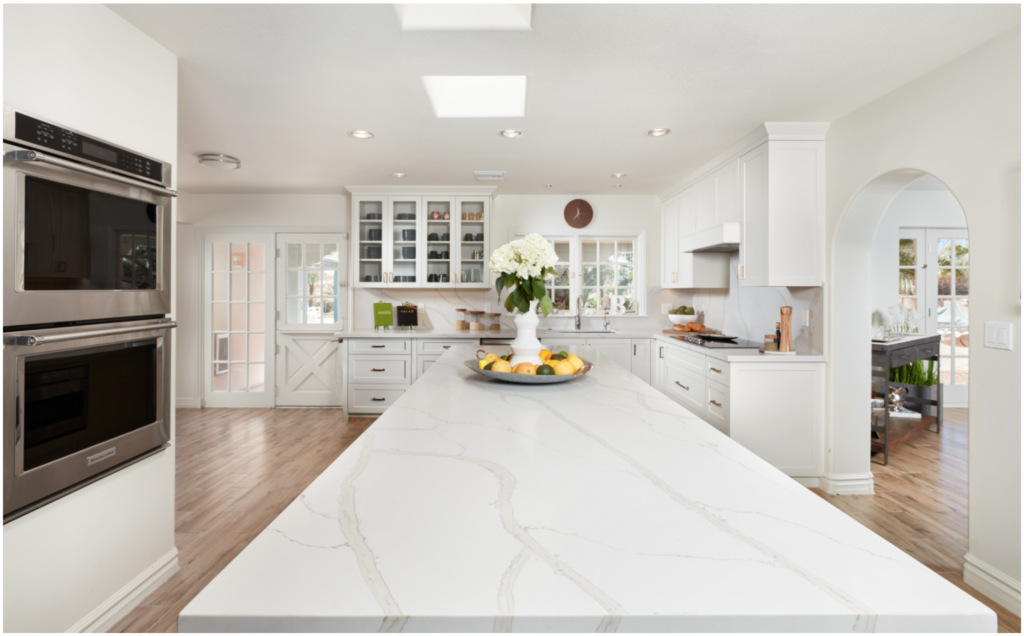
There was a time when most luxury homes featured granite countertops in their kitchen and bathrooms, thanks to its glamorous look and durability. But the countertop decision making process has gotten a little more complex, now that there are many options for countertop materials in the mix.
Enter quartz: an engineered material that offers homeowners an incredible number of benefits, which accounts for its unprecedented popularity. Quartz is one of the most popular materials in Austin home design today, with more and more people choosing to install quartz countertops in new home construction or remodeling projects.
There are multiple countertop surfaces in the market today and truth be told, one specific material isn’t an overall “better” choice than the others. However, there might be a better option for you – either as a homeowner or a builder. If you’re in the market for new countertops, as a contractor or homeowner, then we feel quartz needs to be on your radar. Stick around and keep reading to find out why.
Engineered quartz comprises up to 94% quartz mixed with resin and polymers, topped with pigments for color. Quartz is one of the hardest and most abundant minerals, which makes it an excellent countertop material.
Apart from durable and attractive (a combo that doesn’t happen often, you usually get one or the other), there are many reasons why quartz is increasingly popular among homeowners who are remodeling.
Excellent Durability
As mentioned earlier, quartz is a mixture of natural quartz stone and polymer resins. Investing in a quartz countertop for your bathroom and kitchen design is something that will stand the test of time. Additionally, quartz countertops are available at a variety of price points, therefore there is something for every budget.
Countertops are often exposed to daily wear and tear. Your lifestyle, including whether you have children and/or pets, your cooking style, etc. are all factors that should be considered when selecting your countertop material.
Quartz is highly durable, however it is always recommended to use a hot pad or trivet with pots and pans, to avoid placing hot items directly on your quartz surface. Quartz is not porous, and therefore is resistant to staining. Plus, most quartz countertops (depending on the finish you select) do not require sealing.
If you have an active family or you do a lot of cooking, then you need a countertop that can keep up with your lifestyle. Quartz should definitely be on the list of possibilities for anyone that needs a countertop that sees a lot of action.
Uniform Appearance
Due to the fact that quartz is a man-made product, it is manufactured with tight tolerances; therefore, colors are consistent from slab to slab. Depending on the quartz you choose and its pattern/movement, similar to natural stone countertops, you will see a clear pattern of movement.
While stone countertops have a non-uniform appearance because they are each unique and made by nature, quartz countertops show uniformity. Quartz countertops are more consistent in design, which can be an attractive feature for modern remodeling preferences.
Many colors offer the fabricator open ground to experiment with different cuts to maximize the quartz slab usage. Your kitchen and bathroom countertop can be whatever shape you like. Matching your quartz countertop with the style of your floors and walls creates a uniform appearance throughout the material.
Nobody sets out to remodel or build with the idea of a mediocre outcome, right? When you consider your overall design style, if uniformity is at the top of your list for key elements, then you might want to take a good look at quartz.
Extremely Low Maintenance
Another reason why quartz countertop popularity is growing among Austinites for their residential remodel is that they are non-porous and resistant to stains. With quick and easy spill removal, you don’t have to worry about your countertop getting spoiled with food, wine or oil.
All you need to do is wipe your countertop clean when accidents happen, and restore your sparkling countertop to pristine condition! Polished quartz countertops do not need regular refinishing or sealing. They will retain their appearance for many years. Simple cleaning is all it takes with quartz countertops. The ideal cleaner for quartz is a soft cloth using a gentle soap and water. For general maintenance, use denatured alcohol or a pH-neutral cleaner.
Resistant to Mold and Bacteria
Countertops in your kitchen and bathroom are exposed to moisture and water throughout the day, which is why they can develop unsightly and stubborn mold. Now, that’s something that you can see. But did you know your countertops can also serve as an ideal breeding ground for bacteria that aren’t visible to your naked eye?
Being non-porous in nature, quartz countertops are highly resistant to the growth of mold and bacteria, which means one less thing to worry about (especially when tiny hands are involved).
Endless Design Possibilities

Quartz countertops offer endless design possibilities that have led to their massive popularity in home remodeling projects. Since quartz is an engineered material, you’ll find quartz countertops in a huge variety of designs and colors. Manufacturers have also successfully experimented with various finish techniques on quartz, like honed, polished, brushed or concrete-like finish, making quartz an even more alluring choice for your kitchen and bathroom creativity.
What the Experts Say
“Many homeowners that visit our showroom select quartz for their countertops because it provides a sleek and sophisticated look. Designers and homeowners have been attracted to quartz with cool/grey color tones for several years now, but warm tones are making a comeback. We have plenty of both! With 60+ colors of quartz available, we have something for all color palettes in soft subtle veining or dramatic marble looks. When homeowners first walk into a slab showroom, it can be overwhelming and intimidating. Our wonderful staff is always available to assist in the quartz selection process, whether buyers have questions or need suggestions.”
~Heather Haas (Arizona Tile Austin Branch Manager)
Attractive Cost
As with other countertop materials, quartz comes in a variety of price points making it a cost-effective option at a variety of budget levels.
If you live in Austin, Texas and are building a new home or planning a remodel, quartz is a worthy contender in your overall selections for bathroom and kitchen designs. Get in touch with a local surface specialist, such as Austin NARI Member, Arizona Tile to learn more and select the highest quality and most suitable countertop material for your home project.
